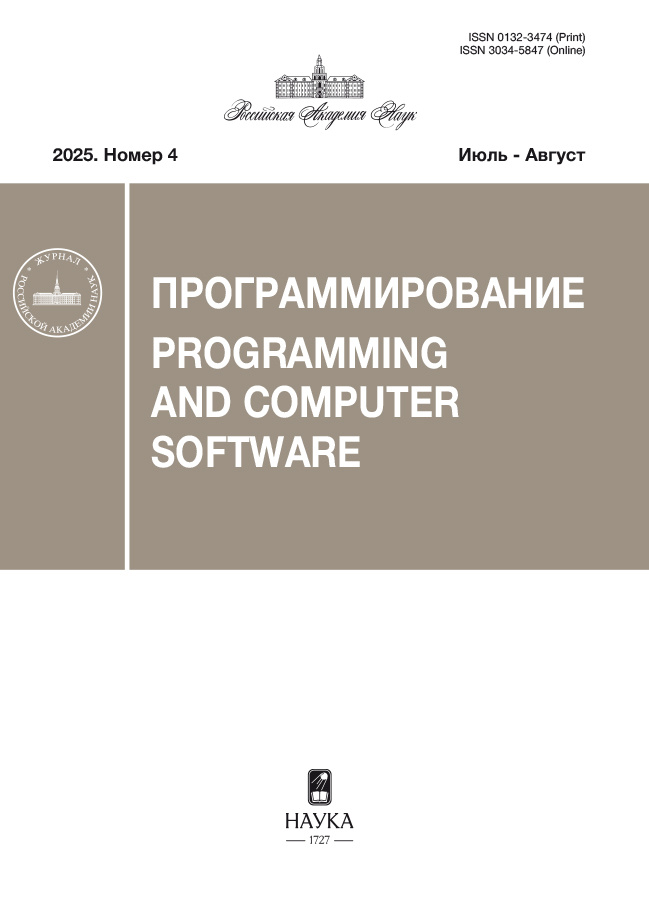Программирование в ограничениях для автоматизированного проектирования интерфейсов
- Авторы: Лозов П.А.1, Косарев Д.С.1, Булычев Д.Ю.1
-
Учреждения:
- Санкт-Петербургский государственный университет
- Выпуск: № 4 (2025)
- Страницы: 57-70
- Раздел: ЯЗЫКИ, КОМПИЛЯТОРЫ И СИСТЕМЫ ПРОГРАММИРОВАНИЯ
- URL: https://rjmseer.com/0132-3474/article/view/695672
- DOI: https://doi.org/10.7868/S3034584725040051
- ID: 695672
Цитировать
Полный текст
Аннотация
В работе рассматривается задача автоматизированного проектирования графических интерфейсов пользователя (GUI). Система, основанная на программировании в ограничениях, принимает правила расположения элементов управления, сами элементы и выдает некоторое количество расположений, удовлетворяющих правилам. Система реализована как веб-приложение и позволяет получать ответы постепенно за разумное время.
Ключевые слова
автоматизированное проектирование GUI, графические интерфейсы пользователя, система проектирования интерфейсов, программирование в ограничениях, расположение элементов управления, веб-приложение для проектирования интерфейсов, автоматизация дизайна интерфейсов, правила расположения элементов, генерация вариантов расположения, интерактивные системы проектирования
Об авторах
П. А. Лозов
Санкт-Петербургский государственный университет
Email: lozov.peter@gmail.com
199034, Санкт-Петербург, Университеская наб., д. 7–9
Д. С. Косарев
Санкт-Петербургский государственный университет
Email: d.kosarev@spbu.ru
199034, Санкт-Петербург, Университеская наб., д. 7–9
Д. Ю. Булычев
Санкт-Петербургский государственный университет
Email: dboulytchev@math.spbu.ru
199034, Санкт-Петербург, Университеская наб., д. 7–9
Список литературы
- Haft M., Humm B., Siedersleben J. The Architect’s Dilemma – Will Reference Architectures Help? Quality of Software Architectures and Software Quality, 2005. P. 106–122.
- Ergonomics of human-system interaction – Part 210: Human-centred design for interactive systems. ISO 9241-210:2019, International Organization for Standardization, 2019.
- Gerber E., Carroll M. The psychological experience of prototyping. Design Studies. 2012. V. 33. № 1. 2012. P. 64–84.
- Friedman D.P., William W.E., Kiselyov O., Hemann J. The Reasoned Schemer. The MIT Press, 2nd edition, Cambridge, USA, 2005. 224 p.
- Lozov P., Verbitskaia E., Boulytchev D. Relational Interpreters for Search Problems. In miniKanren and Relational Programming Workshop, 2019.
- Leonardo de Moura, Bjørner N. Z3: An Efficient SMT Solver. Tools and Algorithms for the Construction and Analysis of Systems, Springer Berlin Heidelberg. 2008. P. 337–340.
- Bengfort J. Thin vs. Thick vs. Zero Client: What’s the Right Fit for Your Business? Online. https://biztechmagazine.com / article / 2018 / 10 / thin-vs-thick-vs-zero-client-whats-right-fit-your-business-perfcon (accessed: 10.11.2024)
- IntelliJ platform UI guidelines: Layout (online). JetBrains s.r.o., 2000–2022. https://jetbrains.github.io / ui / principles / layout (accessed: 10.11.2024)
- Garey M.R., Johnson D.S. Computers and intractability. Vol. 174. San Francisco: Freeman, 1979.
- Kosarev D., Boulytchev D. Typed Embedding of a Relational Language in OCaml. Electronic Proceedings in Theoretical Computer Science. 2016. P. 1–22.
- Kiselyov O., Chung-chieh Shan, Friedman D.P., Amr S. Backtracking, Interleaving, and Terminating Monad Transformers: (Functional Pearl). In Proceedings of the Tenth ACM SIGPLAN International Conference on Functional Programming, New York, USA, 2005. P. 192–203.
- Rozplokhas D., Vyatkin A., Boulytchev D. Certified Semantics for Relational Programming. Programming Languages and Systems, APLAS 2020, Lecture Notes in Computer Science. V. 12470. Springer, Cham. P. 167–185.
- Comon H. Disunification: A Survey. Computational Logic – Essays in Honor of Alan Robinson. MIT Press. 1991. P. 322–359.
- Alvis C.E., Willcock J.J., Carter K.M., Byrd W.E., Friedman D.P. cKanren: miniKanren with Constraints. Proceedings of the 2011 Annual Workshop on Scheme and Functional Programming, 2011.
- Byrd W.E., Friedman D.P. aKanren A Fresh Name in Nominal Logic Programming. In Scheme and Functional Programming, 2007.
- Abramov S., Glück R. From Standard to Non-Standard Semantics by Semantics Modifiers. International Journal of Foundations of Computer Science. 2001. V. 12. № 2. P. 171–211. DOI: 10.1142 / S0129054101000448.
- Abramov S., Glück R. Combining Semantics with Non-standard Interpreter Hierarchies. FST TCS 2000: Foundations of Software Technology and Theoretical Computer Science, Springer Berlin Heidelberg. 2000. P. 201–213.
- Byrd W.E., Holk E., Friedman D.P. MiniKanren, Live and Untagged: Quine Generation via Relational Interpreters (Programming Pearl). Proceedings of the Annual Workshop on Scheme and Functional Programming, Association for Computing Machinery, New York, USA, 2012. P. 8–29.
- Byrd W.E., Ballantyne M., Rosenblatt G., Might M. A Unified Approach to Solving Seven Programming Problems (Functional Pearl). Proceedings of ACM Program. Lang., Association for Computing Machinery, New York, USA, 2017. P. 8:1–8:26.
- Kosarev D., Lozov P., Boulytchev D. Relational Synthesis for Pattern Matching. Programming Languages and Systems, Springer International Publishing, Cham. 2020. P. 293–310.
- Guthmann O., Strichman O., Trostanetski A. Minimal Unsatisfiable Core Extraction for SMT. 2016 Formal Methods in Computer-Aided Design (FMCAD), Mountain View, CA, USA, 2016. P. 57–64. DOI: 10.1109 / FMCAD.2016.7886661.
- React: A JavaScript Library for Building User Interfaces. Meta Platforms, Inc. https://reactjs.org / (accessed: 10.11.2024)
- Jetpack Compose. Android Developers. https://developer.android.com / compose (accessed: 10.11.2024)
- Streamlit framework site. https://docs.streamlit.io (accessed: 10.11.2024)
- Streamlit layouts and containers. https://docs.streamlit.io / develop / api-reference / layout (accessed: 10.11.2024)
- Borning A. Wallingford: Toward a Constraint Reactive Programming Language. Companion Proceedings of the 15th International Conference on Modularity, Association for Computing Machinery, New York, NY, USA, 2016. P. 45–49. DOI: 10.1145 / 2892664.2892667.
- Badros G.J., Borning A., Stuckey P.J. The Cassowary Linear Arithmetic Constraint Solving Algorithm. ACM Trans. Comput.-Hum. Interact., vol. 8, iss. 4, Association for Computing Machinery, New York, NY, USA, 2001. P. 267–306. DOI: 10.1145 / 504704.504705.
- Cai B., Luo J., Feng Z. A novel code generator for graphical user interfaces. Scientific Reports. 2023. V. 13. DOI: 10.1038 / s41598-023-46500-6.
- Bielik P., Fischer M., Vechev M. Robust relational layout synthesis from examples for Android. Proc. ACM Program. Lang., vol. 2, Association for Computing Machinery, New York, NY, USA, 2018. DOI: 10.1145 / 3276526.
- Android ConstraintLayout widget. https://developer.android.com / reference / androidx / constraintlayout / widget / ConstraintLayout (accessed: 10.11.2024)
- Brückner L., Leiva L.A., Oulasvirta A. Learning GUI Completions with User-defined Constraints. ACM Trans. Interact. Intell. Syst., vol. 12, Association for Computing Machinery, New York, NY, USA, 2022. DOI: 10.1145 / 3490034.
- Shiripour M., Dayama N.R., Oulasvirta A. Grid-based Genetic Operators for Graphical Layout Generation. Proc. ACM Hum.-Comput. Interact., vol. 5, Association for Computing Machinery, New York, NY, USA, 2021. DOI: 10.1145 / 3461730.
- Swearngin A., Wang C., Oleson A., Fogarty J., Amy J. Ko. Scout: Rapid Exploration of Interface Layout Alternatives through High-Level Design Constraints. Proceedings of the 2020 CHI Conference on Human Factors in Computing Systems, 2020.
Дополнительные файлы











